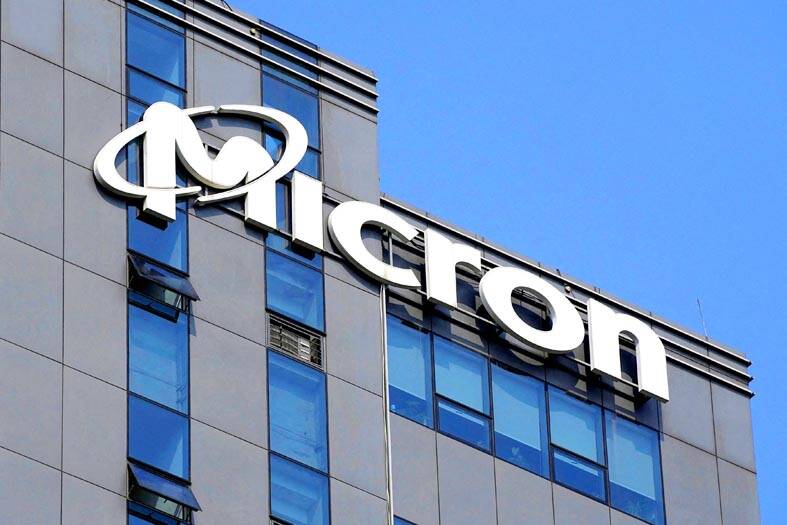The US plans to award Micron Technology Inc US$6.1 billion in grants and as much as US$7.5 billion in loans to help the memory-chip maker build new US factories, rounding out a slew of major federal awards for advanced semiconductor manufacturing.
Micron pledged to invest about US$125 billion to build four factories in New York state and one in Idaho.
The company has separately applied for federal funding to support a project in Virginia, documents filed last week showed.

Photo: Reuters
US President Joe Biden is traveling to Syracuse, New York, as part of the event and plans to discuss how his agenda is shoring up the economy.
It would still be months before Micron actually receives any of the funding from the 2022 Chips and Science Act, which set aside US$39 billion for grants and US$75 billion worth of loans to boost US chipmaking and reduce reliance on Asia. Preliminary agreements like the one Micron announced yesterday trigger a due-diligence stage, after which the money would be handed out over time in tranches tied to construction and production benchmarks.
“The US$6.1 billion will supercharge Micron to bring back leading-edge memory manufacturing to the US,” Senate Majority Leader Chuck Schumer of New York told reporters ahead of the announcement. “We cannot have these chips made overseas and let them be made by competitors like China.”
One plant that is already under construction in Boise would receive funding and be poised for production in 2026. Two more in the Syracuse area of New York state would be built and ready for manufacturing in 2028 and 2029. Micron also is planning two other facilities in New York that are not covered by the scope of yesterday’s preliminary agreement.
Computer memory is a vital part of everything from smartphones to supercomputers and works alongside processors made by companies such as Nvidia Corp and Intel Corp. The funding award guarantees that Micron would proceed with its first cutting-edge manufacturing expansion in the US in more than 20 years.
However, the expansion comes with risks for Micron. Memory chips have volatile prices because the components are built to industry specifications. That means they are interchangeable, resulting in a commodity-like market. Rapid swings between shortages and gluts have characterized Micron’s history and made sustained profitability difficult to achieve. It reported a net loss of more than US$5 billion last year — just a year after posting a huge profit.
US Secretary of Commerce Gina Raimondo previously said that advanced chipmakers had requested more than double the amount of grant money set aside for them. The department allocated about US$28 billion of the US$39 billion pool for top-of-the-line facilities.
The four main advanced manufacturers building in the US — Micron, Intel, Taiwan Semiconductor Manufacturing Co (台積電) and Samsung Electronics Co — are set to receive a combined US$27.6 billion in grants. The only other company that does such production, South Korea’s SK Hynix Inc, has committed to building a US packaging facility. That means the US would become the only country in the world with facilities run by all of the top manufacturers.
Micron’s projects are expected to generate 20,000 jobs spanning construction and manufacturing, the US Department of Commerce said. The company has also signed labor agreements with construction unions for its New York and Idaho sites, and its Chips Act grant sets aside US$40 million specifically for workforce training.

Taiwanese suppliers to Taiwan Semiconductor Manufacturing Co. (TSMC, 台積電) are expected to follow the contract chipmaker’s step to invest in the US, but their relocation may be seven to eight years away, Minister of Economic Affairs J.W. Kuo (郭智輝) said yesterday. When asked by opposition Chinese Nationalist Party (KMT) Legislator Niu Hsu-ting (牛煦庭) in the legislature about growing concerns that TSMC’s huge investments in the US will prompt its suppliers to follow suit, Kuo said based on the chipmaker’s current limited production volume, it is unlikely to lead its supply chain to go there for now. “Unless TSMC completes its planned six

Intel Corp has named Tasha Chuang (莊蓓瑜) to lead Intel Taiwan in a bid to reinforce relations between the company and its Taiwanese partners. The appointment of Chuang as general manager for Intel Taiwan takes effect on Thursday, the firm said in a statement yesterday. Chuang is to lead her team in Taiwan to pursue product development and sales growth in an effort to reinforce the company’s ties with its partners and clients, Intel said. Chuang was previously in charge of managing Intel’s ties with leading Taiwanese PC brand Asustek Computer Inc (華碩), which included helping Asustek strengthen its global businesses, the company

Power supply and electronic components maker Delta Electronics Inc (台達電) yesterday said second-quarter revenue is expected to surpass the first quarter, which rose 30 percent year-on-year to NT$118.92 billion (US$3.71 billion). Revenue this quarter is likely to grow, as US clients have front-loaded orders ahead of US President Donald Trump’s planned tariffs on Taiwanese goods, Delta chairman Ping Cheng (鄭平) said at an earnings conference in Taipei, referring to the 90-day pause in tariff implementation Trump announced on April 9. While situations in the third and fourth quarters remain unclear, “We will not halt our long-term deployments and do not plan to

The New Taiwan dollar and Taiwanese stocks surged on signs that trade tensions between the world’s top two economies might start easing and as US tech earnings boosted the outlook of the nation’s semiconductor exports. The NT dollar strengthened as much as 3.8 percent versus the US dollar to 30.815, the biggest intraday gain since January 2011, closing at NT$31.064. The benchmark TAIEX jumped 2.73 percent to outperform the region’s equity gauges. Outlook for global trade improved after China said it is assessing possible trade talks with the US, providing a boost for the nation’s currency and shares. As the NT dollar